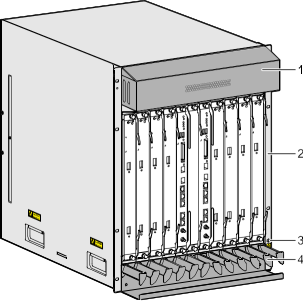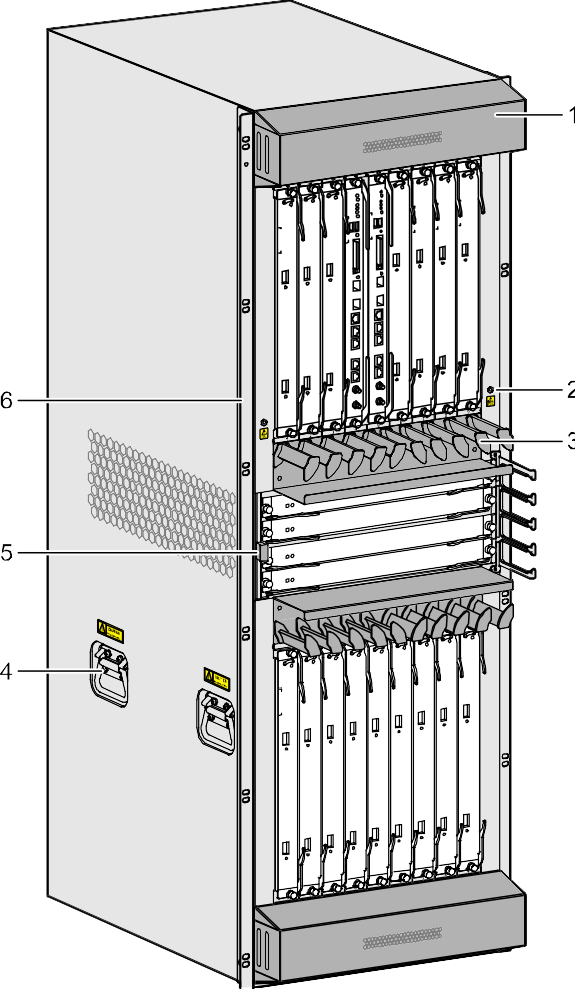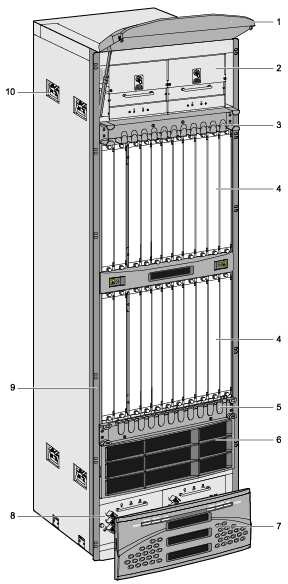





Enterprise Firewall UGW9811 UGW9810 PGP-16 PGP-X8 PGP-X16 subracks Product Description GGSN9811 T8280 T8290 CoreNetwork
A subrack is a mandatory device and houses UGW9811 boards, including the Switching Route Units (SRUs), Switching Fabric Units (SFUs), Service Processing Units (SPUs), and Line Processing Units (LPUs).
The UGW9811 supports PGP-16, PGP-X8, and PGP-X16 subracks.
The design of the PGP-16 subrack complies with the IEC297 standard. Its dimensions (h × w× d) are 62.99 in × 17.40 in × 26.34 in (1600.00 mm × 442.00 mm × 669.00 mm).
1.LCD 2. Fan module 3. Upper cable trough 4.Board cage
5. Lower cabling trough 6.Air intake frame
7.Plastic panel of the power supply module
8.Power supply modules 9.Rack-mounting ear 10.Handle
Entire-system specifications of the UGW9811 (PGP-16)
|
Item |
Specification |
|
Cabinet |
N68E-22 |
|
Dimensions (h × w × d) |
86.61 in × 23.62 in × 31.50 in (2,200 mm × 600 mm × 800 mm) |
|
Weight |
350 kg (in full configuration) |
|
Load-bearing capacity |
> 600 kg/m² |
|
Power input |
−48 V DC to −60 V DC |
|
Typical power consumption of subrack |
4300 W (in full configuration) |
|
Noise (acoustic power) |
< 72 dBA at 23°C (Noise varies with ambient temperature.) |
The design of the PGP-X16 subrack complies with the IEC297 standard. Its dimensions (h × w × d) are 17.40 in × 25.59 in × 55.91 in (442.00 mm × 650.00 mm × 1420.00 mm).
1 Air intake vent 2. ESD jack
3. Cabling trough 4. Handle
5. SFU board cage 6. Rack-mounting ear
Entire-system specifications of the UGW9811 (PGP-X16)
|
Item |
Specification |
|
Cabinet |
N68E-22 |
|
Dimensions (h × w × d) |
86.61 in × 23.62 in × 31.50 in (2,200 mm × 600 mm × 800 mm) |
|
Weight |
340 kg (in full configuration) |
|
Load-bearing capacity |
> 600 kg/m² |
|
Power input |
−48 V DC to −60 V DC |
|
Typical power consumption of subrack |
5800 W (in full configuration) |
|
Noise (acoustic power) |
< 72 dBA at 23°C (Noise varies with ambient temperature.) |
The design of the PGP-X8 subrack complies with the IEC297 standard. Its dimensions (h × w× d) are 17.40 in × 25.59 in × 24.41 in (442.00 mm × 650.00 mm × 620.00 mm).
1 Air intake vent 2. Rack-mounting ear 3. ESD jack 4. Cabling trough
Entire-system specifications of the UGW9811 (PGP-X8)
|
Item |
Specification |
|
Cabinet |
N68E-22 |
|
Dimensions (h × w × d) |
86.61 in × 23.62 in × 31.50 in (2,200 mm × 600 mm × 800 mm) |
|
Weight |
220 kg (in full configuration) |
|
Load-bearing capacity |
> 600 kg/m² |
|
Power input |
−48 V DC to −60 V DC |
|
Typical power consumption of subrack |
3300 W (in full configuration) |
|
Noise (acoustic power) |
≤ 72 dBA at 23°C (Noise varies with ambient temperature.) |
UGW9811 consists of SRUs/MPUs, SFUs, SPUs, and LPUs.
The SRU is the core circuit board for system management. The SFU performs the data exchange function. The SPU performs the service processing function. The LPU provides physical interfaces that connect the UGW9811 to NEs or external networks.
The SRU/MPU, as the main control and switching unit of the UGW9811, is responsible for centralized control and management and data exchange. The SRU/MPUs work in 1+1 backup mode. The SRU/MPU is composed of the main control unit, switching unit, system clock unit, synchronous switching clock unit, and system maintenance unit.
The SFU supports expeditious data exchange. The SFUs work in load-sharing or backup mode and can support line-rate switching of 640 Gbit/s (160 Gbit/s x 4) traffic.
The UGW9811 is equipped with two independent SFUs and two SFU modules inserted in two SRUs.
The SPU performs service control, user packet forwarding, flow control, QoS, and content resolution functions. The SPUs work in load-sharing or N+1 or 1+1 backup mode. The operating mode is defined in the license file. In 1+1 backup mode, the SPUs guarantee service reliability.
The LPU provides the following physical interfaces that connect the UGW9811 to external networks:
FE (10/100 Mbit/s) interface
GE (1000 Mbit/s) electrical interface
GE (1000 Mbit/s) optical interface
GE (10 Gbit/s) optical interface
The LPU is composed of three modules: LPU module, switching network fabric adaptor (FAD) module, and physical interface card (PIC) module.
These three modules work together to quickly process and forward service data. In addition, they maintain and manage link protocols and forwarding information base (FIB) tables.



